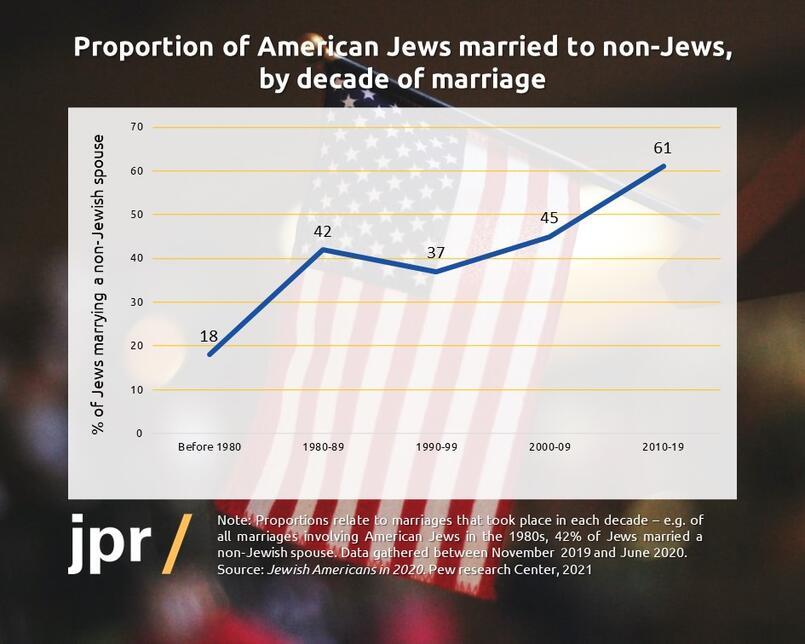Six out of every ten American Jews now marrying out
Dr Jonathan Boyd
Download 'Whose Passover is it anyway', our 2024 Passover family quiz, and test your family's knowledge of Jews in the UK today while reading the Haggadah. Happy Passover from the Institute for Jewish Policy Research!
Dr Jonathan Boyd
Even among American Jewish leaders, reaction to the latest national survey of American Jews, conducted by the Pew Research Center in Washington DC, has been rather muted. That is surprising because national surveys of American Jews only occur every decade or so, and often provoke serious debates about the future of American Jewish life. Indeed, the 1990 National Jewish Population Survey (NJPS) prompted a huge re-think of Jewish priorities both in the US and around the world, resulting in a dramatic increase in funding for Jewish educational initiatives to try to engage and inspire the young generation.
One key NJPS finding spawned that effort. The study found that 52% of American Jews who had married between 1985 and 1990, had a non-Jewish spouse. Previous studies demonstrated that proportion had been rising steadily decade after decade, but crossing the 50% barrier for the first time caused widespread shock and dismay. Something had to be done.
Much has been done. Numerous Jewish schools have been established. Israel programmes have become normative. Stunning Jewish community centres have been built, countless adult education programmes have been created, a plenitude of Jewish cultural festivals have taken off.
And yet, whilst challenging that 52% NJPS finding for the late 1980s, the new Pew report has found that the intermarriage rate among American Jews who married between 2010 and 2020, has reached a new historic high, at 61%.

Notwithstanding methodological differences between studies, the trend over time is clear. And yet, listening to some American Jewish leaders reflecting on the new findings, there is little evidence of that 1990 angst. Just an acceptance of the reality and even, on occasion, a view that this shouldn’t be seen as bad news at all.
That’s partly because a new generation of American Jewish scholars argue vociferously that intermarried Jewish couples can, and often do, bring up their children as Jews. Their work is often based on small and selective qualitative samples, and it quite commonly advocates both for much more tolerance for intermarriage, and an end to what the researchers see as an obsessive focus on it as a measure to highlight the weakening of Jewish life, which, they argue with some justification, maligns and alienates intermarried couples. The research is often quite personal – several such scholars are themselves part of intermarried families – and at times, academic debate about the issue is extremely heated and ideological, as the values of inclusion and diversity become increasingly important orthodoxies in the social sciences. Researchers holding more traditional positions report feeling increasingly as if they need to hold their tongues; their views, even when strongly evidence-based, are not terribly welcome.
Yet the quantitative data on intermarriage are painfully clear. The Pew study demonstrates that whereas 93% of in-married Jews bring up their children as Jews, only 28% of out-married Jews do likewise. Admittedly, there is a grey area here – a further 41% of the latter group bring up their children with some semblance of Jewishness – but even accounting for that, they still lag far behind in-married Jewish couples. So whilst there are no blanket rules, the odds of an in-married couple passing on their Jewishness to their children remain considerably better than those of an intermarried couple.
So what accounts for the strangely muted reaction to the record-breaking finding that six in ten of all American Jews who got married over the past decade have a non-Jewish spouse? In part, it’s due to the growing strength of Jewish research that refuses to critique intermarriage, rejects existing quantitative assessments on the grounds that the numbers would change if communities adopted a more welcoming and inclusive approach, and ardently promotes inclusion. But, in part, it may simply be the result of the new reality. With so many intermarried couples, American Jewish leaders are no longer talking about an abstract phenomenon. They’re talking about their own children, or grandchildren, or even themselves. The scales have tipped, and the issue is now so ingrained, it’s becoming difficult to even talk about it, let alone address it.
It’s important that Jewish community leaders – and Jews in general – can talk about this issue without prejudice. For some, ‘marrying out’ remains among the most heinous decisions a Jew can make; for others, it matters little, if at all – such particularism feels antiquated. But empirically, marriages between Jews and non-Jews are less likely to produce Jews the next generation than marriages between two Jews. Understanding why, and discussing what, if anything, to do about it, is arguably more important than ever.
Executive Director
Executive Director
Jonathan has been Executive Director of JPR since 2010, having previously held research and policy positions at the JDC International Centre for Community Development in...
Read more